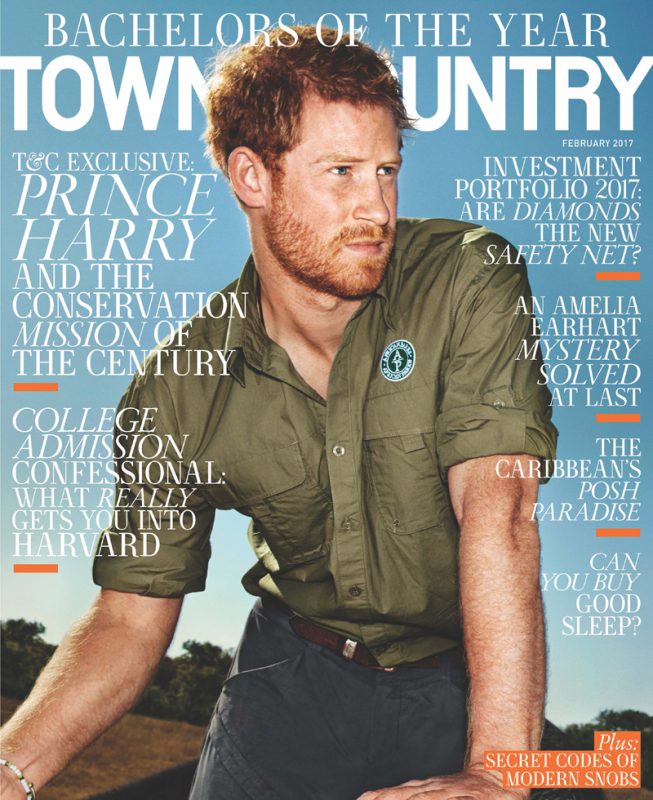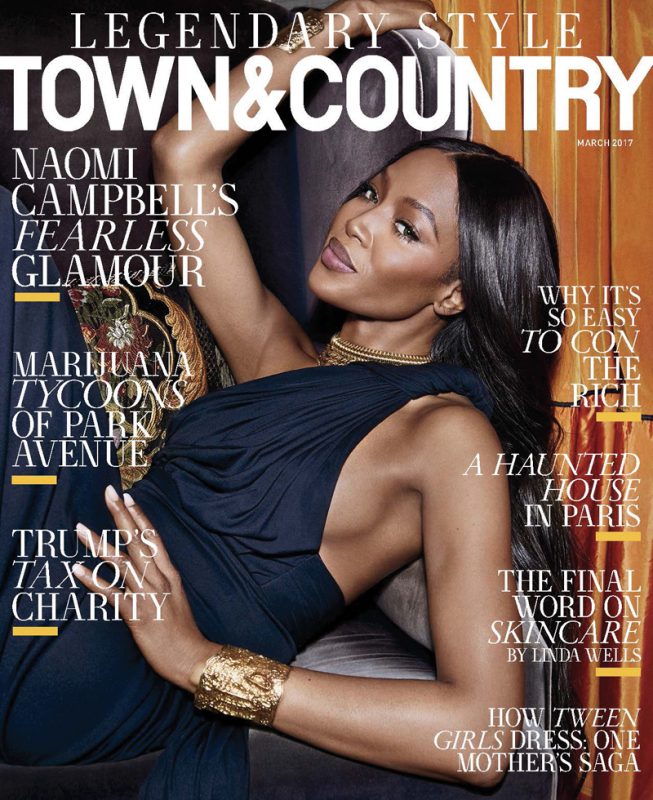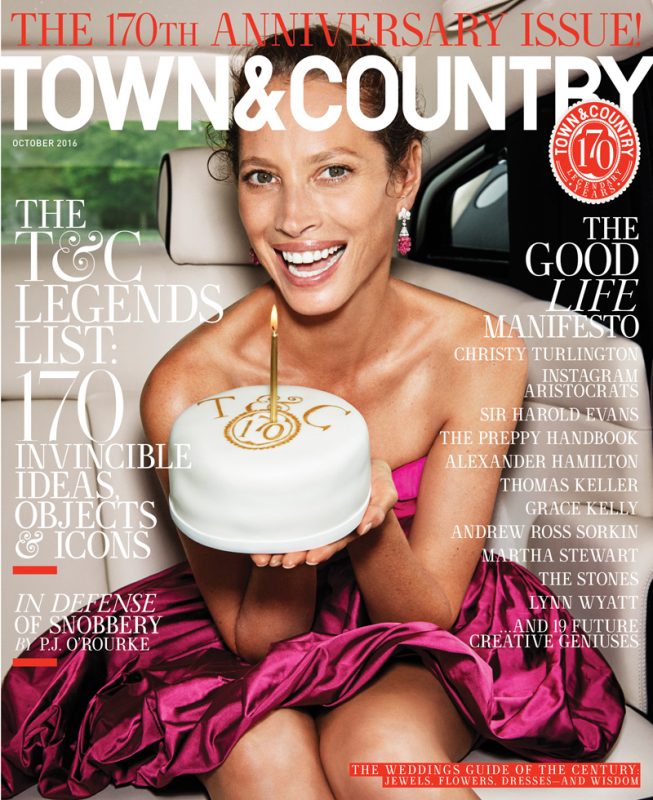There are few people who might have been better prepared to run Town & Country than Stellene Volandes. When she was appointed editor in chief of the 170-year-old Hearst glossy in March 2016, she had already been the magazine’s executive style director for the past two years. Plus, with eight years at Departures, three years at Vogue, and a master’s in English lit from Columbia—she was an obvious choice. And did we mention she’s a jewelry guru with a recently published tome by Rizzoli? Volandes fills us in on her rise to the top.
What was it like making the transition from style director to editor in chief?
The thing about being the style director at Town & Country is that style really infiltrates every single thing we cover. Even though the title of style director at some magazines is very fashion or jewelry focused, style actually informs how we cover real estate and society, and politics, and art, so I really had my hand in so many different areas. It was smoother than it probably would have been otherwise. I was also lucky enough that so many of my editors now were my great colleagues before. They really rallied around me from the moment the announcement was made.
You have always been both a writer and an editor.
Exactly. I think our magazine is about amazing visuals and beautiful photography. But it’s as much about great journalism and great writing, and I think we cover a world and certain subjects that some people see as frivolous, but we cover them with as much intelligence and integrity as we do anything else. And that has always been so important to me.
How did you celebrate when you got the job?
I went with a few of my colleagues to Marea and had aperol spritz in the afternoon and ordered every dessert on the menu. And I have friends who were so generous. People like David Monn, Richard Story, Brooke Neidich, and Cornelia Guest threw me a wonderful series of parties, for what seemed like months after. It was a really wonderful time.
How did you choose to decorate your office?
Will Kahn, our fashion market and accessories director, decorated my office. I became editor in chief, and three days later I was out of the office for about a week at the Baselworld watch show. I came back and my office had been completely transformed. I’m not a neat editor, at all. Will comes in here and establishes order. Usually, there are shoes on the floor and the desk has coffee, Smartwater, and a million newspapers, so don’t be deceived.
What was the scariest part about becoming editor in chief?
The fear was equaled by the excitement. When we all got here six years ago, we all believed so much in the magazine and we worked hard to make it into what we knew it could be. I was so grateful to continue with the same staff. We all love Town & Country, and I hope it shows. It helps that I have a family of colleagues.
How involved is former EIC Jay Fielden?
No one could have prepared me for this job better than Jay. He has taught me how to do this job, without him here in the office. We both work so well together, and I feel so lucky that he’s a phone call or three floors away. It is a huge privilege.
You really built your early career at Departures. What did you learn from Richard David Story?
I was actually his and Michael Boodro’s assistant at Vogue for three years first. Then I left publishing and went to grad school for English literature. I taught at LaGuardia High School for two and a half years. But when I wanted to come back to publishing, Richard was the one who welcomed me back at Departures, where he had become editor in chief. Richard has been the EIC of Departures for many years and he is still as enthusiastic about the magazine, the stories, and the writers as the day I first started working there. If that enthusiasm dampens, it’s evident on the pages and Richard’s has not. And I hope mine never will. Departures really exposed me to the world of luxury. He was really adamant, as am I now, about separating what is quality and what is really sort of frivolous and ridiculous. You want to treat your audience with respect. If you’re writing about a million-dollar necklace, you need to explain why that necklace is worth a million dollars. Richard’s influence on my career, my life, and really my taste, is immeasurable.
What has been the most exciting story “get” since you’ve been here?
The 170th anniversary issue for October 2016 was probably the biggest challenge of my first year, but also the most exciting. It was all hands on deck, and the staff came together like we’ve never come together before. We didn’t take no for an answer from anybody and assembled a dream cast of contributors. Also looking at our March issue, and seeing Naomi Campbell on the cover is something that means so much to us. The richness of those visuals is so Town & Country. There’s another story in the March issue that I love on the Musée Nissim de Camondo in Paris. I went there last Fashion Week and met a wonderful writer, James McAuley, who’s based in Paris and is the American correspondent to the Washington Post. He wrote one of the most tragic family stories I have ever read. The family owned the museum, it was their house, but the last remaining family members were wiped out by the Holocaust. They were really important collectors, and their family tree ended in 1943. It’s very much a story about how important a collection can be to your legacy.
In that issue, you also did an impressive package on T&C’s Guide to Living. How did that come together?
That essay collection might be one of my favorite things we’ve done. It was a way to take the idea of etiquette and turn it on its head and make it about behavior and modern-day crises, and the people who live them day-to-day tell you how they navigate it. We had Martha Stewart on self-reliance. Jessica Seinfeld on your kid getting rejected from kindergarten. Johnny Pigozzi on how to be the life of the party. That’s what T&C has always been. It’s a world of voices and personalities and authority, but always told with a little bit of humor. You don’t want to fall back into how to fold a napkin. Our readers know that. We look at the feats and the follies of the 1 percent, and both are really fun.
Speaking of! We also love the Manners & Misdemeanors column.
Did you read “The Seven Stages of Etiquette Rebellion”? That’s one of my favorites of last year. David [Netto] is a great friend of the magazine, and the tone is perfect for T&C. If someone agrees to pick you up at the airport and isn’t there when you get off the plane, can you leave? It’s straight talk. Ultimately, that’s what people want.
Do you have any etiquette things that you’re a stickler about in the office?
I think what I’m a stickler about is Instagram, and I really try to lead by example. We’re so lucky to be invited to the most amazing places, the most fun parties, and to give our readers that access on a daily basis. I think it’s part of our responsibility as editors. I’m also sort of crazy about what a hed is on a piece of jewelry or a really beautiful shoe. I really hate cliché display. If you’re going to tell your reader to pay attention to a bag that costs $6,000, the display should also be $6,000 display.
You recently published a book on jewelry. Did you finish it before you took on the EIC role?
It looked like it happened at the same time, but it didn’t really. Thank goodness! I had submitted my completed manuscript to Rizzoli about a week before it was announced that Jay was going to Esquire. I went on no weekend brunches for a year. It wasn’t ducking out of the office to see James de Givenchy for an hour—it was spending a whole weekend with him as he sorted stones. It let me also pay tribute to jewelers. I’m sort of a jewelry evangelist, I think.
What’s the most amazing piece of jewelry that you’ve featured in T&C?
The first big piece I wrote for Town & Country was on Golconda diamonds. It also tells the story of jewelry in a way that I wish people would understand. The Golconda diamond mines are depleted, but they are considered the holy grail of diamonds. You realize that jewelry is a natural wonder. When the mines are depleted, that’s it. The reason we wrote that story is because suddenly Golcondas were fetching these insane prices at auction. Suddenly, people were marketing type 2A diamonds, which have the same sort of chemical makeup as Golconda, but they’re not from the historical mine. There was this controversy and this sudden rush for Golconda and that intersection is really the heart of what makes a Town & Country story. The other one was meeting Lauren Adriana, thanks to Rebecca Selva at Fred Leighton, who is my jewelry fairy godmother. Lauren just turned 30, and is making some of the pieces that I think will be the masterpieces of the century.
The Prince Harry cover was quite a get.
Alexei Hay, the photographer, and Klara Glowczewska, who wrote the story, really made this one happen. Klara had spearheaded a series of stories for us with notable philanthropists. We’ve gone to Haiti with President Bill Clinton, Batswana with Uma Thurman, and we did a water.org trip with Matt Damon. Klara found out that Prince Harry takes this conservation movement seriously, and African Parks Network came to Klara with this story, because of the other stories that she’s done, and invited Klara up to Malawi to accompany Prince Harry.
What did Klara tell everyone at the office about Prince Harry?
She said that he’s beautiful! And that he is as charming as you would expect.
Was it hard to choose the cover photo of him?
Well, look at the cover. What do you think? [Laughs] There were about 20,000 images, but I think you would agree, the cover shot was an easy choice.
What’s been your hardest story to procure?
The hardest, but ultimately one of our most successful, is the profile we did in October on Thomas Keller. It was the hardest in that we really wanted it to be a very frank and honest conversation. It came about a few days after that New York Times review. I got out of a cab in front of the Time Warner building and he was there, walking into Per Se, and I just thought, “My God! After that review, how do you go back into the kitchen?” We knew that it was a Town & Country story. Our readers are great clients of his, but it’s also for our readers who occupy the highest places in their industry, because it is also a very real story about getting kicked in the teeth and getting back up again. We worked really hard to make sure that Chef Keller would be honest and open with the writer, Gabe Ulla. It was the first time he really talked about how he felt, and how he communicated to his staff after that review. It did really well in the magazine, but it also did well online and it was a 3,000-word story. It’s nice to know how to get back in the kitchen, so to speak.
How much do you have to think about print stories being shareable online?
I don’t feel pressure. We don’t assign stories in print thinking, “This will do well online.” One of the top performing stories on our website this year has been our print story about the Romanov family written by Simon Sebag Montefiore, who is an expert on the family. It’s not a top-10 list, and there are no cats in it. A great story is a great story, in print and online.
Read the issue HERE.





